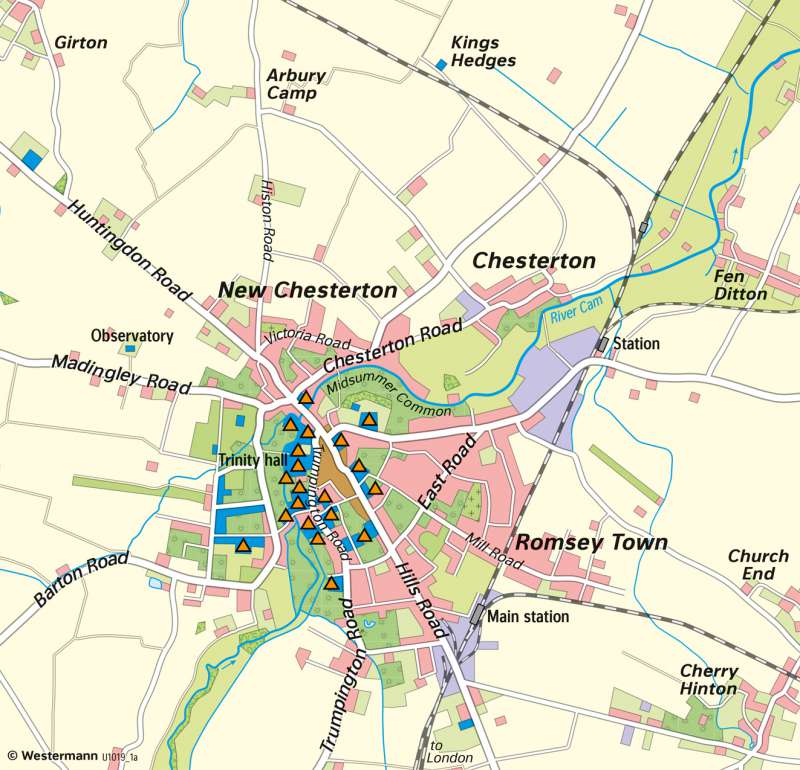Cambridge (England) - Urban development of a university town
Industrial Age
978-3-14-100890-6 | Page 85 | Ill. 3

Overview
The capital of the county of Cambridgeshire is situated 80 kilometres north-east of London on the banks of the River Cam. The first traces of settlement date from the late Bronze Age (1000 B.C.). After the Roman invasion (43 A.D. under Claudius) the existing settlement of "Duroliponte" served the function of defending the Cam, which was crossed here by the Via Devana, a roman road running from Colchester in the south-east to Chester in the north-west. The Romans were followed by the Saxons, who gave the settlement the name of "Grantabrycge". Under the Vikings (from 875) the former centre of the settlement was moved from Castle Hill on the left bank of the river to the right bank. After the Norman Conquest (1066) the Normans built a castle on Castle Hill and the Round Church in the middle of the settlement. The present-day name of "Cambridge" only emerged in later times.
University
A decisive factor influencing the town's development was the University of Cambridge, which dominates the urban landscape even today. The university was founded in 1209 by a group of lecturers and students from Oxford. The University of Cambridge consists of a large number of independent institutions, which take their own decisions on the admission of students and are responsible for their accommodation and welfare. Teaching and research, on the other hand, are organised centrally by the university's faculties and institutes.
The first college was Peterhouse, founded by Hugh de Balsham, Bishop of Ely, in 1284. The second-oldest college is King's Hall, founded in 1317. In 1546 Henry VIII combined it with Michaelshouse to create Trinity College, which even today is the largest and wealthiest college in Cambridge. Among the most striking buildings in the town is King's College, founded in 1441 by Henry VI. In its chapel the Gothic building houses the largest fan vault in the world. A further architectural curiosity in Cambridge is the Mathematical Bridge, made up of triangles and tangents, which has spanned the Cam from Queen's College since the 18th century.
Townscape in 1880
In 1880 Cambridge had around 35,000 inhabitants. The townscape was dominated by the historical buildings of the university colleges. 20 of today's 31 colleges already existed at this time. Many of the buildings dated from the 15th century, when large parts of the existing town were demolished to make way for the university's construction. Most of the college buildings were grouped around the town centre on Hills Road. On the Cam, north of the town centre – as today – were the college boathouses. The importance of rowing for Britain's traditional universities is shown by the "Oxford and Cambridge Boat Race", a regatta that has been held on the Thames since 1829.
In 1880 Cambridge was connected to the national road network and had rail connections to London as well as other lines to the north, east and west. The first signs of the start of industrialisation were to be seen in an industrial area at Chesterton in the north of the city.
Townscape in 1880
In 1880 Cambridge had around 35,000 inhabitants. The townscape was dominated by the historical buildings of the university colleges. 20 of today's 31 colleges already existed at this time. Many of the buildings dated from the 15th century, when large parts of the existing town were demolished to make way for the university's construction. Most of the college buildings were grouped around the town centre on Hills Road. On the Cam, north of the town centre – as today – were the college boathouses. The importance of rowing for Britain's traditional universities is shown by the "Oxford and Cambridge Boat Race", a regatta that has been held on the Thames since 1829.
In 1880 Cambridge was connected to the national road network and had rail connections to London as well as other lines to the north, east and west. The first signs of the start of industrialisation were to be seen in an industrial area at Chesterton in the north of the city.




